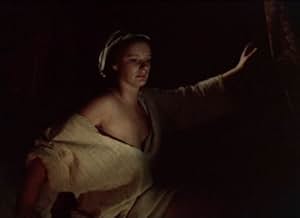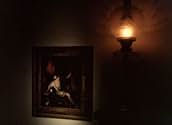Füge eine Handlung in deiner Sprache hinzuCan Schalcken save his love, Rose, from the clutches of a ghastly suitor before it is too late?Can Schalcken save his love, Rose, from the clutches of a ghastly suitor before it is too late?Can Schalcken save his love, Rose, from the clutches of a ghastly suitor before it is too late?
- Regie
- Drehbuch
- Hauptbesetzung
Charles Gray
- Narrator - Lefanu
- (Synchronisation)
Sarah Parry
- Model
- (Nicht genannt)
Empfohlene Bewertungen
There's no point repeating what other viewers have said - this is one of the great lost classics of BBC television.A stunning piece of work, and the climactic scene is both erotic and horrific.
It may not originally have been "A Ghost Story for Christmas", but I'm sure it was shown in that slot at some point in the 80s.
There was a companion piece made in 1987 - again with Charles Gray as narrator - this time based on an incident the life of Italian painter Cariani. It was called Cariani and the Courtesans, and starred a pre-Withnail Paul McGann.
It lacks the atmosphere or the horror of the earlier piece, but it's worth a look if the chance ever presents itself.
It may not originally have been "A Ghost Story for Christmas", but I'm sure it was shown in that slot at some point in the 80s.
There was a companion piece made in 1987 - again with Charles Gray as narrator - this time based on an incident the life of Italian painter Cariani. It was called Cariani and the Courtesans, and starred a pre-Withnail Paul McGann.
It lacks the atmosphere or the horror of the earlier piece, but it's worth a look if the chance ever presents itself.
The young lover of a student artist in 17th century Holland is spirited away in marriage by her guardian to a grim, wealthy suitor. Years pass, and the student becomes successful, but then he finds her again ...
A strange, cold story, with a fabulously eerie climax. Shot with all eyes on recreating the image of Dutch interiors, still lifes and portraits from the era, and very spare with the dialogue. I did feel the lovers' relationship should have been given more substance, but the performances are excellent, and the psychology of the protagonist is deep and not easy to understand. The outstanding theme is the treatment of women as objects, but the message is complex and rounded out with inevitable terror as life's betrayals and compromises accumulate.
Pace is a little slow and solemn. Music is harpsichord, sometimes contrasting in mood with what's on screen.
Overall, very interesting and the scene in the vault is a good 'un.
A strange, cold story, with a fabulously eerie climax. Shot with all eyes on recreating the image of Dutch interiors, still lifes and portraits from the era, and very spare with the dialogue. I did feel the lovers' relationship should have been given more substance, but the performances are excellent, and the psychology of the protagonist is deep and not easy to understand. The outstanding theme is the treatment of women as objects, but the message is complex and rounded out with inevitable terror as life's betrayals and compromises accumulate.
Pace is a little slow and solemn. Music is harpsichord, sometimes contrasting in mood with what's on screen.
Overall, very interesting and the scene in the vault is a good 'un.
I saw it and taped it when it went out and have never forgotten it. Sadly that was on Betamax in a former life. I agree entirely with everyone's observations on the piece.
And I have seen the original painting. Many years ago I was stood in the doorway of a huge room in an English stately home, listening to the information being given by the guide when I casually glanced to my left.
This was a very warm summer's day but my blood froze. I was resting against a wall covered in paintings and there next to my left elbow was the very painting of the girl shielding the candle, with her ghastly suitor's face in the shadows...
I can't remember which house it was though it might have been Woodstock near Oxford. But I will never forget that shock! The piece, from the Omnibus series, does still exist as a print so there is still hope...
And I have seen the original painting. Many years ago I was stood in the doorway of a huge room in an English stately home, listening to the information being given by the guide when I casually glanced to my left.
This was a very warm summer's day but my blood froze. I was resting against a wall covered in paintings and there next to my left elbow was the very painting of the girl shielding the candle, with her ghastly suitor's face in the shadows...
I can't remember which house it was though it might have been Woodstock near Oxford. But I will never forget that shock! The piece, from the Omnibus series, does still exist as a print so there is still hope...
This visual adaptation of Joseph Sheridan le Fanu's short story is, as I remember, as faithful to the pace and tone of the original work as any film I've come across. As compelling as the story, and lit in a way evocative of Vermeer and Schalken, it proceeds with an attention to static detail and earthiness that one normally associates with Dutch interior pictures of the 17th century, adding to this already addictive blend the grim inevitability of a supernaturally sinister social deal based on personal gain. Anyone interested in this period of Dutch history will gain much enjoyment from this film - paradoxes abound in this curious world of high art, dedication, order, status, lust, pecuniary gain, moral, (and physical), corruption. Truly a lost masterpiece.
Nicely-handled period ghost story (by the renowned Irish author J. Sheridan LeFanu, of "Carmilla" fame) that is somewhat lengthy at 70 minutes; its backdrop of classical Dutch painting is, however, admirably evoked throughout in the subdued and tasteful quality of the photography that also extends to the occasional nudity on display which, given the subject matter, was inevitable. The two notable names within the cast each play principal roles: Maurice Denham – from NIGHT OF THE DEMON (1957) – as Schalcken's mentor and John Justin – from the definitive 1940 version of THE THIEF OF BAGDAD – as the mysterious and wizened rich visitor who barters with the former for the hand of his niece (who is secretly in love with the titular figure). Incidentally, both painters truly existed and, apparently, the story was concocted as a means of explaining the sudden change in Schalcken's style of painting and especially the 'story' behind one particular canvas in which he depicts himself defending the honor of his beloved and about to strike at something vaguely visible with a sword!
Wusstest du schon
- WissenswertesVincent Price was a front runner for The Narrator. Peter Cushing was offered the part but rejected the project as distasteful.
- Patzer14 minutes in, as Schalcken abandons his painting and walks towards Rose, Jeremy Clyde's footsteps on the floor are not in synch with the footsteps we hear.
- Zitate
Narrator - Lefanu: In short, Schalcken was in love... as much as a Dutchman can be.
- SoundtracksIn Nomine
(uncredited)
Music by John Bull
Top-Auswahl
Melde dich zum Bewerten an und greife auf die Watchlist für personalisierte Empfehlungen zu.
Details
- Erscheinungsdatum
- Herkunftsland
- Sprache
- Auch bekannt als
- Schalcken, o Pintor
- Drehorte
- BBC Ealing Studios, Ealing, London, England, Vereinigtes Königreich(Gerrit Dou's studio and all exteriors)
- Produktionsfirma
- Weitere beteiligte Unternehmen bei IMDbPro anzeigen
Zu dieser Seite beitragen
Bearbeitung vorschlagen oder fehlenden Inhalt hinzufügen

Oberste Lücke
By what name was Schalcken the Painter (1979) officially released in India in English?
Antwort


























